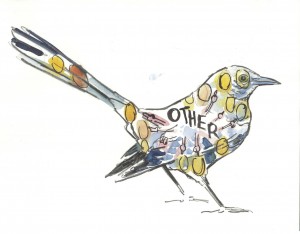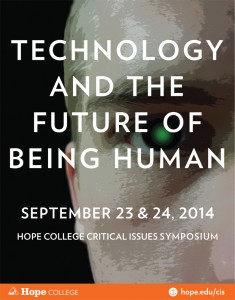Editor’s note: This post by Patrick Morgan is in regards to the recent Critical Issues Symposium held at Hope College. Contact Patrick at morganp@hope.edu
We – the privileged fraction of humanity with enough access to the very basic things (like food, water, and shelter) to allow us both leisure and capital – often take the structures and workings of the numerous intersecting information ecologies in which we participate for granted. Hope College’s 2014 Critical Issues Symposium, being devoted to exploration of “technology” and its cybernetic relationship with, ultimately, some general notion of “humanness,” seems like an ideal opportunity to reflect on libraries’ and information technologies’ role within this context.
It may seem too obvious to point out that this topic is immensely complex. I do so, however, to provide a basic rationale for focusing on just a single, interesting problem that came up during Gloria Mark’s engaging address on 9/24. At its barest, the goal in this short essay is to begin teasing apart the paradoxical problem of analogic digitalization.
I, like many perhaps (or at least, many within the “privileged fraction”), like to speculate on the eventual changes we are wringing on ourselves by our increasingly “data-driven” culture. Like Prof. Mark, I think certain changes in human communication patterns already demonstrate the decisively clear influence of, for example, even archaic technologies like SMS (texting); you certainly won’t need to wander far if you need proof.
In her well-known essay “The Cyborg Manifesto,” Donna Haraway also discussed the reciprocal nature of tech-human interaction. Her focus was on the transformative nature of our technologies to alter both our bodies and our ideas about them, and even their contexts¹. It is not difficult to make the leap from machine-organism interaction to code-organism interaction, both occurring, ultimately, on the border between humans and the dehumanizing technologies we create to make life “better.” Analogically similar they are; in terms of effect, however, the stakes are interestingly different.
Prof. Mark noted that certain complex human phenomena – like conversation – digitize poorly. This is to say that information, when carried over from an analogical, organic process into the digital world, is inevitably lost. MP3s, convenient as they are, can suffer from a lack of tonal depth for this very reason. I completely agree that this is worth talking about. However, this forces us to confront certain assumptions as well, a few of which are fundamental to the work she discussed, and which could appear paradoxical.
I was struck, in particular, by the way her study attempted to digitize human experience in general. In examining the connections between social media or email and mood, for example, data were gathered by measuring certain physiological manifestations of stress (like heart rate, etc.). This raises a number of related questions. Here are just a few I have found myself thinking about:
- How exactly does one appropriately convert human emotion (or some other subjectively-experienced phenomenon) to something digitally manipulable?
- With that in mind, if even a human practice such as conversation is impoverished in its reduction to the digital, then what can we predict about how digital models of human responses are also impoverished?
- How can such a study differentiate between so-called eustress (“good” stress) and the negative sort?
- With respect to email and emotion, why did the responses appear to vary when mobile and traditional platforms were used to access it?
These questions center on what it means to be a digitally-augmented human, and though they almost certainly differ in at least some (and likely several) ways from your own reactions, I hope they’ll provoke you to keep thinking about the sessions you attended yesterday, and what you yourself found most engaging. That is, after all, the purpose of the CIS in the first place, right?
¹It is worth pointing out that Haraway goes well beyond tech-human symbiosis, centering her discussion on the ways our “cyborginess” affects readings of gender and nonconforming human bodies.



 will be drawn on Friday, October 24. To be eligible, you must DESIGN a mockingbird using the template provided. Copies of the mockingbird template can be found at the CIRCULATION desk, RESEARCH HELP desk, and the MEDIATECH desk.
will be drawn on Friday, October 24. To be eligible, you must DESIGN a mockingbird using the template provided. Copies of the mockingbird template can be found at the CIRCULATION desk, RESEARCH HELP desk, and the MEDIATECH desk.
